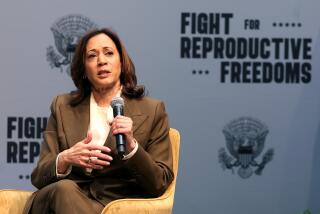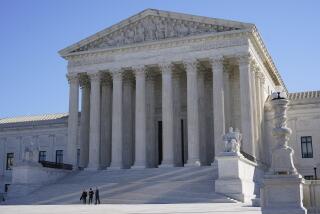Perspective: Lesson from a pre-Roe vs. Wade experience: Men cannot be silent on abortion rights
I was behind the wheel, Charlene beside me, in her powder-blue MG convertible, making our way from the Philadelphia suburbs, through Pottsville and up Route 61 to Ashland, a small, quiet village in the heart of Pennsylvania’s fading anthracite region.
The beautiful two-hour drive turned somber as we approached 531 Centre Street, the office of Dr. Robert Spencer. Charlene was two months pregnant. We were both 19 — students at Haverford and its sister college, Bryn Mawr. We had hoped the legendary physician, known for performing thousands of illegal and affordable abortions, could help us.
Spencer was a pillar of the community, willing to go into the mines to treat injured workers. Although he had been indicted twice — performing abortions was a felony — local juries had refused to convict. We were, nonetheless, paranoid about our mission. Worried that his phone might be tapped, we had decided to show up without an appointment rather than call ahead. That was a mistake. The clinic was deserted. An assistant finally emerged and told us that Dr. Spencer was out of the country and she didn’t know when he would be back.
That was 57 years ago — 11 years before the Supreme Court, in Roe vs. Wade, legalized abortion — and there were few safe alternatives. We were frightened, embarrassed and reluctant to discuss her pregnancy with friends or family. We had consulted Charlene’s gynecologist, who confirmed she was pregnant and who, while sympathetic, said he was afraid to help us for fear that if caught, he would lose his license and might face jail.
There were newspaper stories about women flying to Sweden, where abortions were readily available, but the cost of getting there was prohibitive. There were also references to abortion clinics in Puerto Rico, but we didn’t know anyone who had gone that route. Dr. Spencer’s assistant had said there was a physician in Jersey City, N.J., who might be helpful, but she didn’t know how to reach him.
Her pregnancy was all we could think about and talk about. We thought we were too immature to be parents, although I thought that might be our only option after a night watching Charlene doing jumping jacks, taking hot baths and eating sticks of cinnamon, all of which were rumored to work but didn’t.
Charlene started asking classmates if they had any leads. She was surprised to learn she wasn’t the only one. A friend in her dorm finally referred us to an osteopath who worked out of a shabby office in one of south Philadelphia’s rougher neighborhoods. He wanted $500, equal today to $4,200 when adjusted for inflation. That was far more than I could afford, but a cousin — who never let me forget it — advanced me the money and a few days later, the osteopath performed the abortion.
I wish the story ended there, but, alas, Charlene began to hemorrhage. The osteopath wouldn’t return our phone calls. She was in terrible pain. Terrified, we again called her gynecologist, who agreed to examine her. He told us he could stop the bleeding with a “D&C” (dilation and curettage) that required her hospitalization and, since she was underage, her parents’ consent. I called and said we were dealing with a medical emergency and that we needed their help. They rushed to the hospital, where their concern turned to shock and anger — not about their daughter’s pregnancy but about my failure to consult them. I felt stupid and guilty.
The gynecologist performed the surgical procedure. I was so relieved to see her alive and out of pain that I barely recalled hearing the doctor tell us that the botched abortion had damaged her uterus, making it unlikely that she could have children. Although we subsequently married, she failed to conceive during the years we were together or later.
I have mostly kept this story to myself, and even now, I find it difficult to write or talk about it. Charlene and I had no regrets about her having the abortion, and she was openly and passionately pro-choice for the rest of her life. (She died of natural causes last year.)
I believe many men, under similar circumstances, have shared my preference for silence while encouraging women to assert their reproductive rights. A recent Pew Research Center poll shows there isn’t a significant difference between the number of women (60%) and men (57%) who think abortion should be legal. Still, most pro-choice men view the campaign for abortion rights as a “women’s issue,” even though we must, obviously, share responsibility for unwanted pregnancies. Bestsellers like “Our Bodies, Ourselves: A Book by and for Women” have understandably given priority to women’s voices. Pregnancy and childbearing create physical risks for women, not men. In doing so, they may have, inadvertently, reinforced the silence of men who respect women’s autonomy, while so many of their patriarchal counterparts routinely speak out against abortion.
How else to explain why only five of 24 members of the Planned Parenthood Federation of America board are men and only two members of NARAL Pro-Choice America’s 15-member board are men? (NARAL did establish a “Men for Choice” initiative seven years ago.)
I have also asserted an editor’s need to make “fairness” a priority when rationalizing my silence. At The Times, for example, our editorial guidelines are appropriate and explicit: “A fair-minded reader of Times news coverage should not be able to discern the private opinions of those who contributed to that coverage.”
While eschewing opinion, I believe burying the facts is neither moral nor noble in the face of heated emotions and recent efforts to make abortion again illegal. I think it important to remind myself and to tell others what life was like before Roe vs. Wade.
In the aftermath of conservative Justice Brett M. Kavanaugh’s Supreme Court appointment, bills restricting abortions have been introduced in many states, hoping they will prompt the Supreme Court to reverse Roe vs. Wade. Last month, Alabama enacted legislation that bans almost all abortions. Alabama doctors convicted of performing abortions could be sentenced to as much as 99 years in prison, and some academics have argued that if the law is upheld, men could be prosecuted under it while women are exempt from criminal punishment. So-called “heartbeat” legislation that could prohibit abortions after six to eight weeks has been passed in several states including Louisiana, Mississippi, Georgia and Ohio. In each of the states, men opposed to abortion controlled the debates and the votes in the legislatures.
The American College of Obstetrics and Gynecology, or ACOG, whose 58,000 members make it the nation’s largest group of physicians providing healthcare for women, says that “where abortion is legal, it is extremely safe” and that “the risk of death associated with childbirth is approximately 14 times higher than that with abortion.” The ACOG warns that “abortion, although still legal, is increasingly out of reach because of numerous government-imposed restrictions targeting women and their healthcare providers.”
The recent spate of antiabortion legislation in Alabama and other states resuscitated long-dormant and traumatic memories that I had suppressed since adolescence. Should Roe vs. Wade be overturned, there will be a spike in illegal abortions resulting in increased injuries and death. The ACOG estimates that before 1973 and the passage of Roe vs. Wade, “1.2 million U.S. women resorted to illegal abortions each year and that unsafe abortions caused as many as 5,000 annual deaths.”
I remain grateful Charlene wasn’t one of them.
Pearlstine is The Times’ executive editor.
More to Read
Sign up for Essential California
The most important California stories and recommendations in your inbox every morning.
You may occasionally receive promotional content from the Los Angeles Times.











